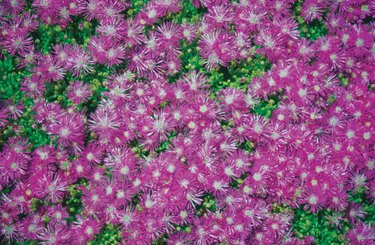
Veterinarians, the American Society for the Prevention of Cruelty to Animals and other agencies warn gardeners to be careful what you plant in your backyard, especially if you have children and dogs. Certain plants like digitalis can poison animals or toddlers who chew on leaves or stems by accident. However, purple ice plant is not one of those problem plants.
Description
Video of the Day
The purple ice plant is a naturally hardy succulent groundcover native to South Africa. One variety is even called the "Hardy" purple ice plant. A perennial common to warmer climates, the purple ice plant grows 2 to 6 inches tall and grows in a loose mat. The foliage is evergreen and produces dozens of brightly colored magenta-to-purple daisylike flowers in mid- to late summer.
Video of the Day
Growth
The plant needs good drainage and doesn't require much water, making it very low maintenance. It grows rapidly and spreads quickly. It serves as soil anchors in much of California's hills and coastline. Purple ice plant grows well on hills and banks and in containers. It loves full sun, warm climates like those in the lower Midwest through the Southeast United States.
Toxicity
The ASPCA lists ice plants of almost all varieties as safe for planting around both dogs and cats. The purple ice plant in particular is safe in yards where pets run free.
Toxic Ice Plant
One variety of ice plant, slender ice plant (Mesembyanthemum nodiflorum) grows almost exclusively in Australia on soils that are poor in areas where sheep-herding is a common industry. Slender ice plant is high in oxalic acid poisonous to sheep. The sheep seek it out, attracted by its high salt content. In time, the sheep develop high oxalic acid levels in their bloodstreams. This interferes with muscle function and may cause paralysis and damage the kidneys. Dogs and cats won't eat enough of the plant to cause problems.
- ASPCA: Animal Poison Control Center
- The Garden Helper: Sun-Loving Groundcovers
- Preen: Tough Plants for Rock Gardens
- i-love-cats.com: Toxic and Non-Toxic Plants for Cats
- Pet Friendly House: Non Poisonous Plants for Dogs and Cats
- Department of Agriculture and Food; Slender Iceplant Poisoning in Sheep; Roy Butler; December 2010